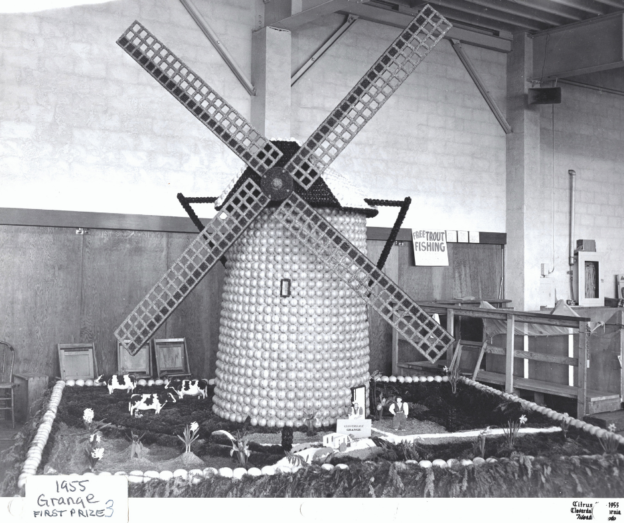
It’s not clear who came up with the idea to call Cloverdale the Citrus Belt of Sonoma County, but George E. Baer, owner, publisher and editor of the local newspaper and all-around promoter was likely involved.
Baer, a native of Pennsylvania, emigrated to California in 1884 at the age of 20. In 1885 he purchased the Cloverdale Reveille from W. S. Walker — becoming the paper’s publisher and editor while simultaneously operating a real estate business, an insurance agency, and a fruit brokerage firm. In 1888, he published “Cloverdale the Orange District of Sonoma County, California: The Home of the Olive and the Fig and all Other Varieties of Fruit.” At various times, Baer also served as Cloverdale’s postmaster, an internal revenue agent and a notary public. Baer was a founding member of the Cloverdale Citrus Fair Association and the Cloverdale Orange Company.
The First Annual Exhibition of the Cloverdale Citrus Fair Association was held in Library Hall on Jan. 27 and 28, 1893. It was coordinated by George Baer, Colonel J.B. Armstrong (think Armstrong Woods), William T. Brush, John Field, and Isaac E. Shaw, and deemed “a tremendous success, despite the rain.”
The citrus exhibits’ artistry and ingenuity won high praise — described as “superb” by the Sonoma Democrat. Along with Baer’s 1888 pamphlet, the Fair advertised to the world that the mild climate and soil conditions of Cloverdale were well suited for growing citrus. Oranges and lemons and grapefruit ripened sooner under the Sonoma County sunshine than in any region of the state and could be shipped East two months before the growers in Southern California had even begun their harvest.
In 1895, the Cloverdale Citrus Fair Association filed articles of incorporation. William T. Brush, John Fields, Michael Menihan and Frederick W. Brush made up the board, along with Charles E. Humbert, who helped found the Sonoma County Farm Bureau in 1917 and served two terms as its president.
At the same time, the Cloverdale Orange Company was established. Its mission was to plant large orange and lemon groves in the Cloverdale area and advance citrus culture in the district. Their first planting occurred in April of 1895 and consisted of 1900 orange and lemon trees. William T. Brush, Simon Pinchower, Wayne P. Ink, Edward F. Woodward and George B. Baer were elected directors.
Citrus planting by the Company and others continued throughout the area. In 1905, George Baer addressed the State Fruit Growers’ Association at their annual convention in Santa Rosa. He spoke about the citrus culture and industry of Sonoma County. As a long-time secretary of the Cloverdale Citrus Fair Association and a major stockholder in the Cloverdale Orange Company who owned a large grove of citrus trees near the “City of Orange Blossoms,” local newspapers declared him exceptionally well qualified to make such a presentation — a presentation in which he declared that “the orange was destined to become a much favored and profitable fruit in Sonoma County.”
By the 1920s, however, several severe frosts had killed off Cloverdale’s commercial citrus industry for good. Yet the Fair continued and has kicked off Sonoma County’s fair season ever since, with three exceptions: In 1915, the Fair was canceled on account of the Panama Pacific International Exposition, which drew funds and crowds away; in 1918 owing to World War I; and in 1944, due to shortages, rationing, and restrictions associated with World War II.
Cloverdale’s Citrus Fair fame increased over the years, attracting visitors from all parts of Sonoma County and California in general. There were even special excursion trains to transport fairgoers from San Francisco. Fair offerings expanded beyond the kaleidoscopic citrus displays to include live orchestral and band music, dancing, vaudeville shows, carnivals, a Citrus Fair Queen contest, a parade, and more.
As the size of the Fair grew, so did the number of buildings it occupied. As mentioned earlier, the first Fair was held in Library Hall on West Street. In 1895 and 1896, the Fair took place in a livery stable owned by Charles Humbert on South West Street. The stable’s hayloft served as a dance floor. Beginning in 1897, a sizeable wood-frame building on West and First Streets hosted the annual event. When it burned in 1909, a reinforced concrete structure was built in its place. In 1951 the Fair moved to its present site on Citrus Fair Drive, where the pavilion and grounds continue to serve as Cloverdale’s central community’s hub.
Not to be deterred by the current pandemic, the Fair will go on in 2021, albeit modified. On February 12, 13, and 14, one will find a drive-thru food frenzy. Not only will traditional tasty fair treats be enjoyed from the comfort of your car, but you’ll be able to take in outdoor exhibits and stationary parade floats. Although the popular Cloverdale Citrus Fair Cabaret group will not be performing live, a streaming video montage of past shows will be available through the Fair’s website. Numerous opportunities to participate in traditional fair activities virtually will be provided. In the meantime, long-time fair goers continue to offer creative ways to contribute to what many regard as an annual town reunion. According to Citrus Fair CEO Katie Young, a hallmark of the Fair has always been co-operation and community pride, and she sees plenty of that these days.
Notes: For those wishing to learn more about Cloverdale’s history and it’s one of a kind fair, check out Jack D. Howell’s Glimpses of the Past. This book is a compilation of articles by the same title, originally published in the Cloverdale Reveille between 1979 and 1996. A visit to the Cloverdale History Center and Museum, which published Images of America Cloverdale in 2008, is also a must (once it opens again).
A digitized version of Cloverdale the Orange District of Sonoma County, California: The Home of the Olive and the Fig and all Other Varieties of Fruit may be obtained from the Sonoma County History & Genealogy Library. Reference staff is available by phone Tuesday thru Thursday from 10 a.m. to 5 p.m. – 707-308-3212 and by email hi*****@***********ry.org
This article is being republished with permission from the Sonoma County Farm Bureau. It was initially published in the bureau’s Farm News.








